There are people out there who don’t know how to write an email.
And at some point, we’ve all received one.
The formatting is weird, it’s full of spelling and grammatical errors — they even got your name wrong.
Sure, it might be spam.
Or it might be someone who hasn’t yet perfected the art of effective email writing.
It takes practice.
These 15 amazing tips will help get you there — whether you’re just learning how to write an email or you’re back to learn some new tricks.
Let’s dive in!

1. Define Your Goals
Before writing a single word of your email, you should be clear about your goals.
A personal email and a professional email can be vastly different, but they share a similar purpose at their cores.
Consider these questions:
- Why are you sending this email? What is the purpose behind it?
- What’s your call to action (CTA)?
- How can you clearly convey your message without confusing the recipient?
- What is the appropriate tone for this recipient?
If you don’t have the answers to some (or all) of those questions, don’t worry — the rest of the tips will help you answer them.
2. Use a Professional Email Address
It all starts here. Why?
Because if your email is “McLovin_Awesome@gmail.com,” you’re already doomed.
First impressions matter. A childish, unprofessional email like the example above will probably be ignored for any number of reasons.
Keep it simple.
Use your first and last name if it’s available. If not, try different configurations of your name — throw in your middle name if you want!
Pro tip: a business email address with a custom domain might help you look more professional, but it isn’t a requirement.
3. When It Comes to Greetings, a Little Personalization Goes a Long Way
Form emails or email templates are helpful, but they can also sound bland and robotic.
Why should your recipient care about your email if you didn’t care to personalize it?
Do a little research. Use their name or mention specific details about their business.
Check the sample email below:
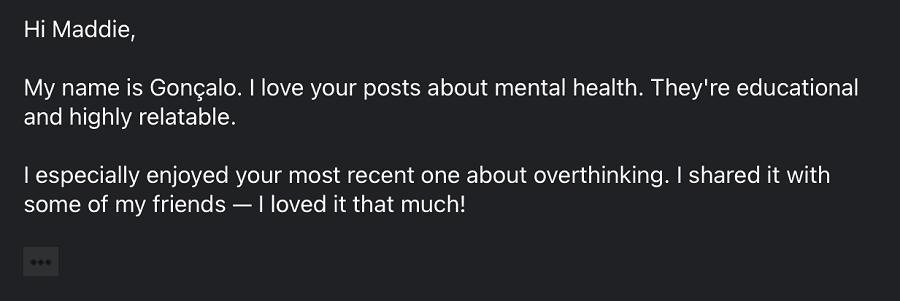
Putting these kinds of details towards the beginning of your email will tell the reader that you took time to get to know them.
It helps you build a rapport, the start of a relationship.
4. Have a Clear Call-to-Action
Getting a reader to take action is one of the most critical aspects of an effective email.
Don’t believe me?
Research shows that emails with a single call-to-action increased clicks by 371%!
That’s MASSIVE. Why wouldn’t you want a piece of that?
There are different types of calls-to-action (CTAs). Here are some examples:
- Setting a meeting. “Please put a quick 15-minute call on my calendar to discuss [subject].”
- Establishing a deadline. “Let’s have this done by Friday. Does that work for you?”
- Following up/wrapping up. “Would you send me the address for KJ’s birthday party?”
Clear CTAs reduce confusion. They tell your recipient exactly what you need from them.
And they will improve your chances of getting a reply.
5. Provide Context
We’ve all received those cold emails, the ones that come out of nowhere and leave you wondering what you need to do.
Context is vital.
You can’t expect the recipient of your email to know what you’re talking about without giving them details to work with.
Let’s break it down with an example:
Say you’re a freelance writer and you’re sending a cold email. You should introduce yourself and let them know why you’re emailing (context).
See for yourself:

The introduction is clear and the details set the stage for the rest of the email.
So, put yourself in your recipient’s shoes and think about what you’d want to know.
6. Keep It Short and Sweet
Attention spans are short and no one will spend 20 minutes reading an email.
In fact, readers might not spend more than 12 seconds on your email!
So what do you do?
Keep it short and sweet.
The Upland post states the ideal email length should be around 50 to 125 words.
Here are some tips to shorten your emails:
- Remove all the filler words.
- Write in the active voice.
- Be engaging but don’t add unnecessary small talk.
There will be situations where you’ll write long emails, but try your best to follow the tips above.
7. Write Conversationally, but Avoid Slang & Initialisms (LOL)
Some people write overly formal emails because they’re afraid of sounding unprofessional.
Take a look:
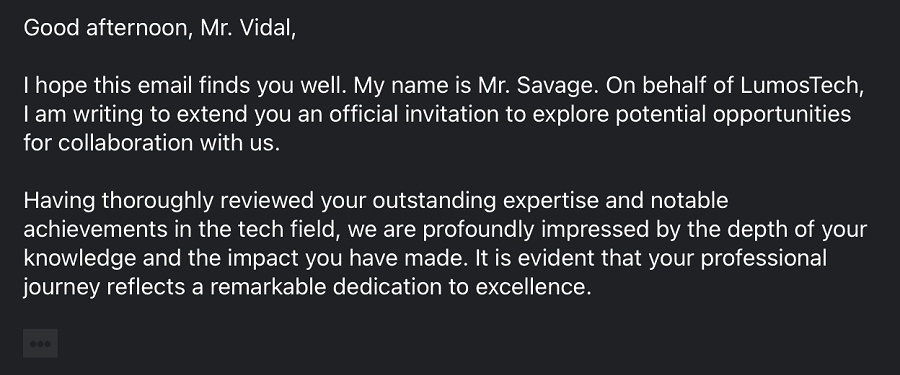
Do you really want to keep reading that?
And then there are people who are writing emails like they’re chatting on Instagram, using slang and emojis:
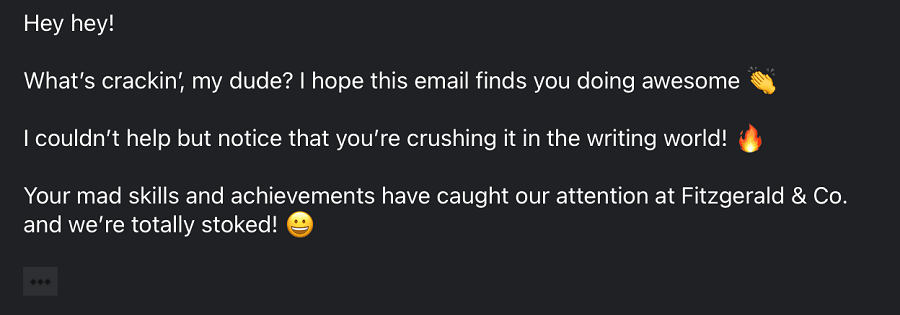
These are both extreme examples but they help illustrate the point. There’s a gray area between a formal email and an informal email, and that’s the tone you should strive for.
You want to be informative and personable. Your recipients will read the whole email if it’s friendly and still coherent.
Pro tip: if you struggle to hear the tone of your writing, try Grammarly’s tone detector.
8. Use Formatting To Enhance Readability
Strategic email formatting is essential. It will improve the readability of your email while also holding your reader’s attention.
So, how should you format your email?
Above all, avoid creating blocks of text like you’re writing an academic article — they’re a nightmare to read.
Check out this example:
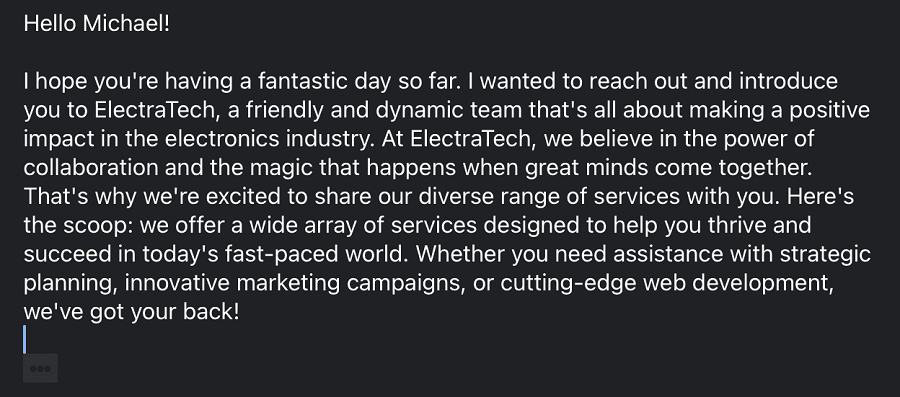
It’s difficult, right?
Try this instead:
- Write short sentences.
- Use bullet points when you can.
- Bold or italicize some words (don’t overuse them).
- Use the same font throughout (including in your signature).
See these tips in action:
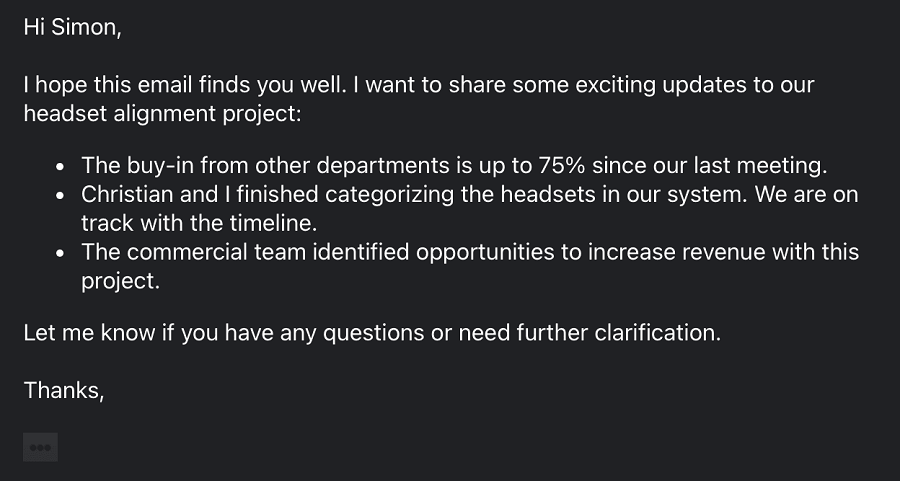
Isn’t that better?
SmartBlogger has a fantastic post about email formatting if you want to dive deeper.
9. Use a Professional Signature
A professional email signature lends credibility to your writing. It’s a good idea to have different templates for different situations.
It might look like this:
Emma Collins Senior Account Executive Alpha Solutions Inc. Phone: +1 (555) 123-4567 Email: emma.collins@example.com Website: www.example.com
Or this:
Michael Thompson Project Manager Tech Innovators Ltd.
Both are acceptable, but consider your recipient and choose the one that aligns best with your email’s tone.
If it’s the first time you’re emailing someone, use the more detailed signature with your job title and contact information. You want to provide everything the recipient might need.
If you’re already acquainted, skip the extra details and use a simpler signature.
10. Craft Your Subject Line Last (Yes, Really!)
That time you spent writing your email makes it easier to sum up the essence of the message and inject it into your subject line.
By writing it last, you ensure that your email subject line aligns perfectly.
Now, how should you craft it? Check the examples below:
- Subject: Unlocking New Possibilities
- Subject: Meeting Request to Discuss Q4 Projects
The first one is too vague and mysterious.
The second is straightforward, succinct, and specific.
Your recipients will get the gist from your email subject line.
You can add a bit of personality, though! As Elna Cain advises in this SmartBlogger post about email marketing:
“When you email your subscribers, your message is competing with every other email in their inbox. If your subject lines are boring, your emails will get ignored.”
With these tips, finding the sweet spot gets easier!
11. Proofread and Edit Your Email — Twice
Those are two terrifying words.
But they can’t be ignored. Whether we want to admit it or not, we all make mistakes.
Grammar mistakes or awkward sentences are death blows to your aspirations of success
In fact, a survey of Linguix’s newsletter subscribers found that 26.3% of the respondents would not even reply to an email containing grammar mistakes or typos.
Though these mistakes affect people differently depending on certain personality characteristics, according to experiments by two language scientists.
My advice? Work smarter.
You can use grammar checkers to make your life easier (or at least this part of it).
For example, Grammarly can be your best friend, saving you from a bad day’s spelling disasters.
12. Be Intentional and Specific When Using CC & BCC
Learning to use CC and BCC correctly is a requirement if you really want to know how to write an email.
These fields are best used for streamlining communication. You want to make sure the appropriate people have the information they need without flooding their inboxes.
But what do they mean? What’s their purpose?
- CC — or carbon copy — is for adding someone to the email who needs the information but might not need to chime in. They will be able to see the addresses in the To field and everyone will see theirs.
- BCC — blind carbon copy — is best for when the same email is going to multiple recipients and you want to keep addresses confidential. The sender is the only one who can see the addresses in the BCC field.
It’s also helpful when the responses only need to go to you, not the whole group.
You really need to consider your contacts and the role they play in each email, don’t you?
13. Nail the Correct Email Etiquette for Any Work Situation

Email etiquette sounds intimidating but it’s really just a fancy way of saying “be kind and respectful.”.
You can read Flowrite’s article for a comprehensive breakdown of perfect email etiquette but we’ve highlighted the most important aspects for you:
- Avoid humor. It doesn’t always come across the way you intended.
- Save the gossip for after work. Emails are not confidential and can easily be forwarded. Don’t ruin a relationship by putting something in writing that you wouldn’t say in person.
- Handle emotional situations offline. Sending a mean or angry email could lead to a lot of miscommunication and hurt feelings.
- “Reply All” sparingly. Really think about it before you make this choice. If you’re constantly choosing “reply all” in unnecessary situations, your colleagues might start to ignore all of your messages.
- Be mindful of idioms and acronyms. This is particularly important if you work with international teams. Just because you know what it means, does not mean it will translate well. Steer clear and you’ll avoid a lot of confusion.
Did any of those surprise you? I’m sure you’ll see an improvement in your work emails once you start employing those pointers.
14. Send Emails When Your Recipient Will Actually Read Them
Scheduling your emails is a great way to increase their efficacy.
Coschedule analyzed 10 research studies to reveal the best time to send emails, so you should check the post for further information.
The main takeaway is: Thursday at 10 a.m. is the perfect time to send an email.
If you’d like to dive into how the other days/times performed, check out the article! However, you should think of those results less like rules and more like guidelines. In today’s world, everyone is reading their email all the time.
Pro tip: be mindful of time zones. Factoring that into your process might give your email a boost!
15. Follow Up Appropriately
It’s been days and you’ve received no response to your latest email.
Maybe your recipient thought they had already responded? Or they were swamped with work and it kept getting pushed to the bottom of their to-do list?
People are busy and sometimes forget to reply — it isn’t personal.
Your follow up email is a gentle reminder that you need a response from them.
So don’t be scared to write it.
Keep it friendly and brief. It may feel like you’re bothering them but most of the time, they’re grateful (I know I am).
Timing is important here. For example, don’t send a follow-up email 24 hours after the first one.
As a general rule, wait 3 to 5 business days before you send a follow-up.
The Bottom Line on How To Write an Email (& Be Successful at It)
15 tips to write an effective email may seem like overkill. After all, it’s just emailing people.
That’s what other people might think — but not you.
You’ll rise to the challenge, practicing all these steps and dazzling your readers with well-written, straight-to-the-point emails.
You’ll be professional and kind, from your greeting to your signature.
And best of all, you’re more likely to get the response you want.
So what are you waiting for? Open up a new email and get started!



